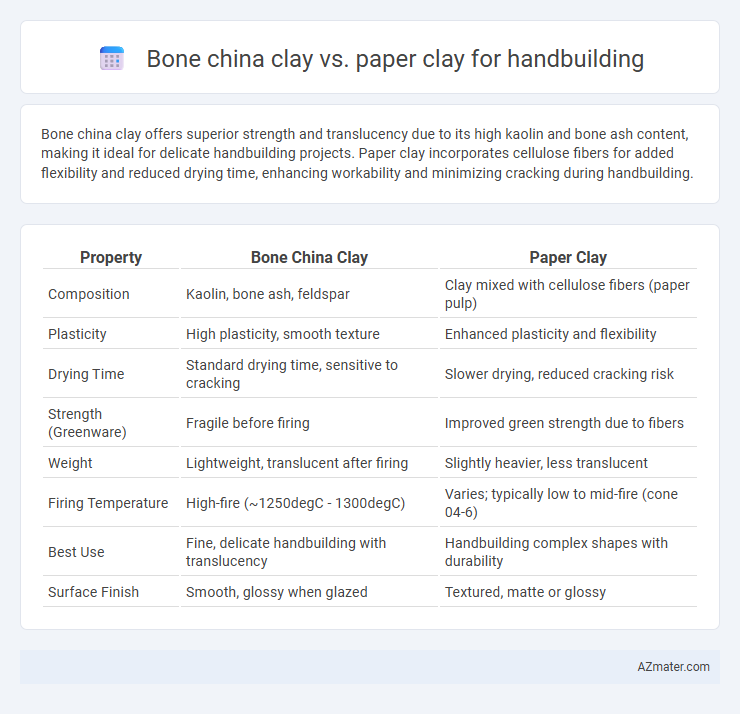Bone china clay offers superior strength and translucency due to its high kaolin and bone ash content, making it ideal for delicate handbuilding projects. Paper clay incorporates cellulose fibers for added flexibility and reduced drying time, enhancing workability and minimizing cracking during handbuilding.
Table of Comparison
| Property | Bone China Clay | Paper Clay |
|---|---|---|
| Composition | Kaolin, bone ash, feldspar | Clay mixed with cellulose fibers (paper pulp) |
| Plasticity | High plasticity, smooth texture | Enhanced plasticity and flexibility |
| Drying Time | Standard drying time, sensitive to cracking | Slower drying, reduced cracking risk |
| Strength (Greenware) | Fragile before firing | Improved green strength due to fibers |
| Weight | Lightweight, translucent after firing | Slightly heavier, less translucent |
| Firing Temperature | High-fire (~1250degC - 1300degC) | Varies; typically low to mid-fire (cone 04-6) |
| Best Use | Fine, delicate handbuilding with translucency | Handbuilding complex shapes with durability |
| Surface Finish | Smooth, glossy when glazed | Textured, matte or glossy |
Introduction to Bone China Clay and Paper Clay
Bone china clay is a refined ceramic material composed primarily of bone ash, kaolin, and feldspar, offering a smooth texture and high strength ideal for delicate, translucent porcelain creations. Paper clay incorporates cellulose fibers into traditional clay bodies, enhancing flexibility and drying durability, which reduces cracking during handbuilding processes and allows for more intricate sculptural forms. Both materials cater to different handbuilding needs, with bone china prized for its fine finish and translucency, while paper clay excels in workability and structural integrity during drying.
Composition and Material Differences
Bone china clay contains bone ash, feldspar, and kaolin, making it dense, strong, and translucent after firing. Paper clay is a mixture of clay and cellulose fibers, which increases its strength and flexibility while drying, allowing for easier handbuilding and joining of wet and dry pieces. The key material difference lies in bone ash's contribution to durability and translucency in bone china, whereas paper clay's fibers enhance workability and reduce cracking during the drying process.
Workability and Texture in Handbuilding
Bone china clay offers fine particle size and plasticity, providing smooth, workable texture ideal for detailed handbuilding and delicate forms. Paper clay contains cellulose fibers that increase strength and flexibility, allowing for extended workability and easy joining of pieces without cracking. Its fibrous texture enhances structural support, enabling construction of larger or thinner handbuilt components.
Strength and Durability Comparison
Bone china clay exhibits superior strength and durability compared to paper clay due to its high kaolin and bone ash content, resulting in a denser, less porous final product. Paper clay offers enhanced flexibility and reduced cracking during handbuilding but tends to be more fragile and less suitable for functional ware requiring high durability. For projects prioritizing structural integrity and longevity, bone china clay remains the preferred material.
Drying and Firing Characteristics
Bone china clay offers a smooth texture and high plasticity, making it ideal for detailed handbuilding, with drying that requires gradual moisture loss to prevent cracking. It fires at high temperatures (around 1250degC to 1280degC), resulting in a strong, translucent finish but is prone to warping if not carefully dried. Paper clay incorporates cellulose fibers, enhancing flexibility and reducing drying cracks, allowing for faster drying times and lower firing temperatures (typically 1000degC to 1100degC), which preserves delicate forms and reduces firing-induced stress.
Shrinkage and Warping Issues
Bone china clay typically exhibits lower shrinkage rates around 10-12%, which reduces warping during handbuilding, while paper clay can shrink up to 15-18% depending on fiber content, increasing distortion risks in drying and firing. The burlap-like fiber reinforcement in paper clay offers improved strength and flexibility, minimizing warping but requires meticulous control over moisture content to prevent cracking. Optimal handbuilding results rely on balancing shrinkage properties and managing drying protocols specifically tailored to either bone china or paper clay formulations.
Surface Finish and Aesthetic Qualities
Bone china clay offers a smooth, translucent surface finish that enhances delicate details and provides a refined, high-gloss aesthetic ideal for elegant handbuilding projects. Paper clay incorporates fibers that create a matte, textured surface with increased strength and flexibility, resulting in a more organic, rustic appearance suitable for expressive, sculptural forms. The choice between bone china and paper clay depends on the desired finish--bone china delivers sleek sophistication, while paper clay emphasizes tactile depth and durability.
Suitability for Detailed Work
Bone china clay offers exceptional smoothness and plasticity, making it ideal for achieving fine details and intricate textures in handbuilding. Paper clay, enriched with cellulose fibers, provides added strength and flexibility, allowing delicate parts to be built and assembled without cracking during drying. Both clays support detailed sculptural work, but bone china clay excels in refined, glossy finishes while paper clay is better for structural integrity in complex forms.
Cost and Accessibility
Bone china clay typically costs more and has limited availability due to its refined composition and specialized firing requirements, making it less accessible for casual handbuilders. Paper clay, infused with cellulose fibers, is more affordable and widely accessible through art supply stores and online, favored for its lightweight and flexible properties during handbuilding. The lower cost and ease of sourcing paper clay make it a practical choice for hobbyists and educational settings seeking versatility without high expenses.
Best Uses and Recommendations
Bone china clay offers exceptional strength and translucency, making it ideal for delicate, fine handbuilt pieces like elegant tableware or decorative sculptures. Paper clay, enriched with cellulose fibers, provides enhanced workability and crack resistance, best suited for larger, textured handbuilding projects or complex assemblages. For durability and refined finish, bone china is recommended, while paper clay excels in experimental, lightweight, and intricately textured forms.

Infographic: Bone china clay vs Paper clay for Handbuilding
 azmater.com
azmater.com